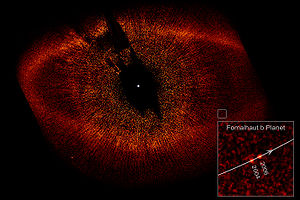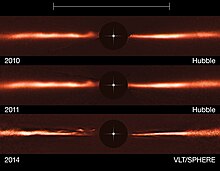
A protoplanetary disk is a rotating circumstellar disc of dense gas and dust surrounding a young newly formed star, a T Tauri star, or Herbig Ae/Be star. The protoplanetary disk may not be considered an accretion disk; while the two are similar, an accretion disk is hotter and spins much faster. It is also found on black holes, not stars. This process should not be confused with the accretion process thought to build up the planets themselves. Externally illuminated photo-evaporating protoplanetary disks are called proplyds.
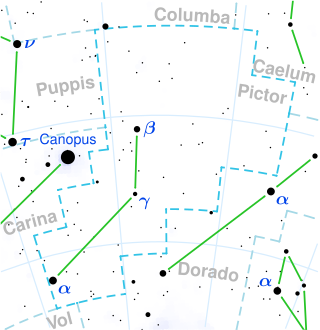
Beta Pictoris is the second brightest star in the constellation Pictor. It is located 63.4 light-years (19.4 pc) from the Solar System, and is 1.75 times as massive and 8.7 times as luminous as the Sun. The Beta Pictoris system is very young, only 20 to 26 million years old, although it is already in the main sequence stage of its evolution. Beta Pictoris is the title member of the Beta Pictoris moving group, an association of young stars which share the same motion through space and have the same age.

AU Microscopii is a young red dwarf star located 31.7 light-years away – about 8 times as far as the closest star after the Sun. The apparent visual magnitude of AU Microscopii is 8.73, which is too dim to be seen with the naked eye. It was given this designation because it is in the southern constellation Microscopium and is a variable star. Like β Pictoris, AU Microscopii has a circumstellar disk of dust known as a debris disk and at least two exoplanets, with the presence of an additional two planets being likely.
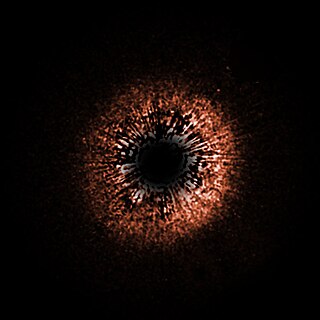
HD 107146 is a star in the constellation Coma Berenices that is located about 90 light-years (28 pc) from Earth. The apparent magnitude of 7.028 makes this star too faint to be seen with the unaided eye.
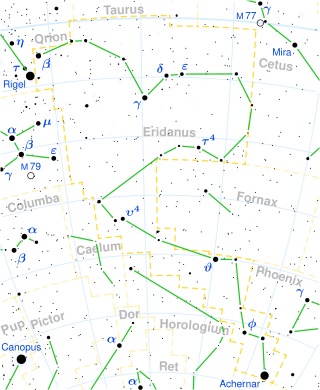
HD 10647 is a 6th-magnitude yellow-white dwarf star, 57 light-years away in the constellation of Eridanus. The star is visible to the unaided eye under very dark skies. It is slightly hotter and more luminous than the Sun, and at 1.75 billion years old, it is also younger. An extrasolar planet was discovered orbiting this star in 2003.
HD 210277 is a single star in the equatorial constellation of Aquarius. It has an apparent visual magnitude of 6.54, which makes it a challenge to view with the naked eye, but it is easily visible in binoculars. The star is located at a distance of 69.6 light years from the Sun based on parallax, but is drifting closer with a radial velocity of −20.9 km/s.
HD 69830 is a yellow dwarf star located 41.0 light-years away in the constellation of Puppis. In 2005, the Spitzer Space Telescope discovered a narrow ring of warm debris orbiting the star. The debris ring contains substantially more dust than the Solar System's asteroid belt. In 2006, three extrasolar planets with minimum masses comparable to Neptune were confirmed in orbit around the star, located interior to the debris ring.
Eta Telescopii is a white-hued star in the southern constellation of Telescopium. This is an A-type main sequence star with an apparent visual magnitude of +5.03. It is approximately 158 light years from Earth and is a member of the Beta Pictoris Moving Group of stars that share a common motion through space. It forms a wide binary system with the star HD 181327 and has a substellar companion orbiting around it, named Eta Telescopii B.

HD 12039, also known as DK Ceti, is a variable star in the constellation of Cetus at a distance of 135 ly (41 pc). It is categorized as a BY Draconis variable because of luminosity changes caused by surface magnetic activity coupled with rotation of the star. The stellar classification G4V is similar to the Sun, indicating this is a main sequence star that is generating energy at its core through the thermonuclear fusion of hydrogen. The effective temperature of 5,585 K gives the star a yellow hue. It has about the same mass as the Sun, but only emits 89% of the Sun's luminosity. This is a young star with age estimates ranging from 7.5−8 million years to 30 million years.

Any planet is an extremely faint light source compared to its parent star. For example, a star like the Sun is about a billion times as bright as the reflected light from any of the planets orbiting it. In addition to the intrinsic difficulty of detecting such a faint light source, the light from the parent star causes a glare that washes it out. For those reasons, very few of the exoplanets reported as of January 2024 have been observed directly, with even fewer being resolved from their host star.

Eta Corvi is an F-type main-sequence star, the sixth-brightest star in the constellation of Corvus. Two debris disks have been detected orbiting this star, one at ~150 AU, and a warmer one within a few astronomical units (AU).
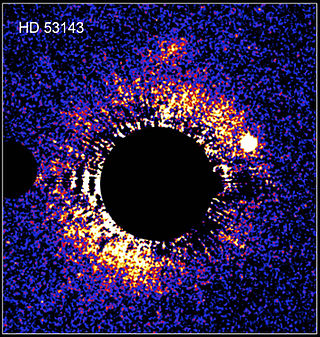
HD 53143 is a star in the Carina constellation, located about 59.8 light-years from the Earth. With an apparent visual magnitude of 6.80, this star is a challenge to view with the naked eye even under ideal viewing conditions.
HD 98800, also catalogued as TV Crateris, is a quadruple star system in the constellation of Crater. Parallax measurements made by the Hipparcos spacecraft put it at a distance of about 150 light-years away. The system is located within the TW Hydrae association (TWA), and has received the designation TWA 4.

HD 113766 is a binary star system located 424 light years from Earth in the direction of the constellation Centaurus. The star system is approximately 10 million years old and both stars are slightly more massive than the Sun. The two are separated by an angle of 1.3 arcseconds, which, at the distance of this system, corresponds to a projected separation of at least 170 AU.
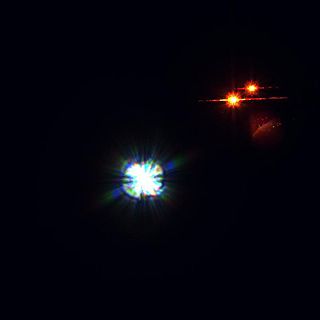
HD 141569 is an isolated Herbig Ae/Be star of spectral class A2Ve approximately 364 light-years away in the constellation of Libra. The primary star has two red dwarf companions at about nine arcseconds. In 1999, a protoplanetary disk was discovered around the star. A gap in the disk led to speculation about a possible extrasolar planet forming in the disk.

HD 172555 is a white-hot Type A7V star located relatively close by, 95 light years from Earth in the direction of the constellation Pavo. Spectrographic evidence indicates a relatively recent collision between two planet-sized bodies that destroyed the smaller of the two, which had been at least the size of the Moon, and severely damaged the larger one, which was at least the size of Mercury. Evidence of the collision was detected by NASA's Spitzer Space Telescope.

Paul Kalas is a Greek American astronomer known for his discoveries of debris disks around stars. Kalas led a team of scientists to obtain the first visible-light images of an extrasolar planet with orbital motion around the star Fomalhaut, at a distance of 25 light years from Earth. The planet is referred to as Fomalhaut b.
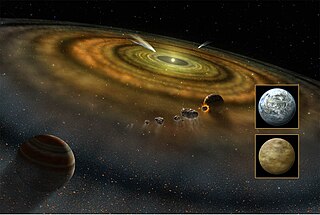
An exocomet, or extrasolar comet, is a comet outside the Solar System, which includes rogue comets and comets that orbit stars other than the Sun. The first exocomets were detected in 1987 around Beta Pictoris, a very young A-type main-sequence star. There are now a total of 27 stars around which exocomets have been observed or suspected.
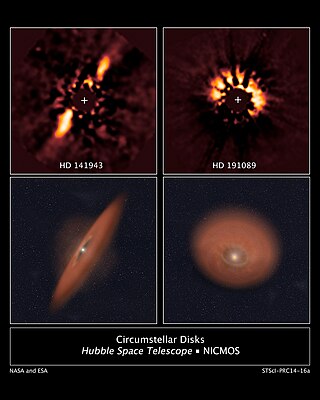
A circumstellar disc is a torus, pancake or ring-shaped accretion disk of matter composed of gas, dust, planetesimals, asteroids, or collision fragments in orbit around a star. Around the youngest stars, they are the reservoirs of material out of which planets may form. Around mature stars, they indicate that planetesimal formation has taken place, and around white dwarfs, they indicate that planetary material survived the whole of stellar evolution. Such a disc can manifest itself in various ways.
